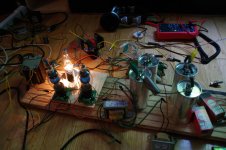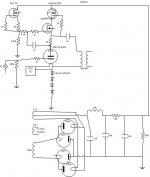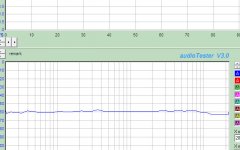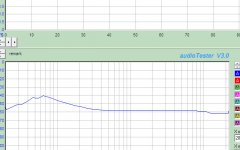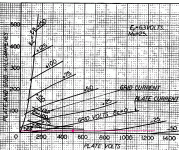While running the filaments overnight won't hurt anything, I have my doubts that it will solve problems with gassiness.
Kevin is correct - you run them at red plate conditions for a few minutes to eliminate the gassiness. When run with red plates, the tantalum plates are 'self-gettering.'
BTW: I run all of my mercury vapor rectifiers with filaments only overnight before initial use.
Jim
Kevin is correct - you run them at red plate conditions for a few minutes to eliminate the gassiness. When run with red plates, the tantalum plates are 'self-gettering.'
BTW: I run all of my mercury vapor rectifiers with filaments only overnight before initial use.
Jim
My apologies for any unintended vagueness.
It should not require more than a few minutes (10 to 20) under red plate conditions to eliminate any gassiness...of course, as long as you are not exceeding the max plate dissipation rating (25 Watts), you can burn them in for hours if you wish.
However, all of the above is only addressing a degassing process for tantalum plate tubes.
For general use in an audio circuit (V1 in a two-stage amp), I run them at 400 to 500 vpk, drawing approx 10 mA.
I have never tried them as output tubes...as an A2 output device, I would have no problem running them at 22-23 Watts dissipation (red plates).
Jim
It should not require more than a few minutes (10 to 20) under red plate conditions to eliminate any gassiness...of course, as long as you are not exceeding the max plate dissipation rating (25 Watts), you can burn them in for hours if you wish.
However, all of the above is only addressing a degassing process for tantalum plate tubes.
For general use in an audio circuit (V1 in a two-stage amp), I run them at 400 to 500 vpk, drawing approx 10 mA.
I have never tried them as output tubes...as an A2 output device, I would have no problem running them at 22-23 Watts dissipation (red plates).
Jim
Hi Jim,
I hope you don't feel I'm trying to box you in. It's actually that, of the people whose posts I've seen on the subject, I believe you are the only one with as much experience as you have with these particular tubes. What I was trying to ferret out was how you've found them over the long haul. Like many others, I have read the data sheets and tech papers and was prepared to think they had to be kept at red or yellow plate conditions and was also thinking that my not doing so was what caused the malfunction of the tubes I tried, but it would change my view entirely if you have run them at cooler (no plate glow) temps for three or four digit hours and never had any trouble.
Thanks yet again
I hope you don't feel I'm trying to box you in. It's actually that, of the people whose posts I've seen on the subject, I believe you are the only one with as much experience as you have with these particular tubes. What I was trying to ferret out was how you've found them over the long haul. Like many others, I have read the data sheets and tech papers and was prepared to think they had to be kept at red or yellow plate conditions and was also thinking that my not doing so was what caused the malfunction of the tubes I tried, but it would change my view entirely if you have run them at cooler (no plate glow) temps for three or four digit hours and never had any trouble.
Thanks yet again
No problem - I don't feel boxed in at all.
I first used 3C24s in early 2002; I was manufacturing a couple of 2-stage all-DHT (semi-) commercial amplifiers, using the AVVT AV20 in the V1 position. Without warning, AVVT went under and I was forced to search for an AV20 replacement - meaning: a generally available DHT with a mu of 20+ that could run at approx 400 v on the plate, drawing 20 mA. While the 3C24's filaments drew more current than I would have initially wished, the 3C24 seemed the best bet to try. I bought a few and was blown away by the sound!
In order to maximize gain, I needed plate chokes - and Dave Slagle stepped in to help; those experiments led us to drop the plate current down to approx 10 mA, a better trade-off due to the inductance required. As long as it continued to sound good, I was unconcerned.
I'm relating this story in large part so that you'll see how my 3C24 experimentation evolved. The bottom line is that I was so pleased with these relatively minimal op points [20 to 25% of max P(d)] that I have not strayed very far. I have 3C24s that have been running at these non-red plate op points for well over 10 years now with zero trouble. In fact, every single 3C24 failure that I can think of occurred within the first hour (or maybe two hours) of use.
Once again, I have no problem with anyone who chooses to run them at 20+ Watts dissipation - especially as an amplifier output device. But, I have never had any problems running them at much lower P(d)s.
Jim
I first used 3C24s in early 2002; I was manufacturing a couple of 2-stage all-DHT (semi-) commercial amplifiers, using the AVVT AV20 in the V1 position. Without warning, AVVT went under and I was forced to search for an AV20 replacement - meaning: a generally available DHT with a mu of 20+ that could run at approx 400 v on the plate, drawing 20 mA. While the 3C24's filaments drew more current than I would have initially wished, the 3C24 seemed the best bet to try. I bought a few and was blown away by the sound!
In order to maximize gain, I needed plate chokes - and Dave Slagle stepped in to help; those experiments led us to drop the plate current down to approx 10 mA, a better trade-off due to the inductance required. As long as it continued to sound good, I was unconcerned.
I'm relating this story in large part so that you'll see how my 3C24 experimentation evolved. The bottom line is that I was so pleased with these relatively minimal op points [20 to 25% of max P(d)] that I have not strayed very far. I have 3C24s that have been running at these non-red plate op points for well over 10 years now with zero trouble. In fact, every single 3C24 failure that I can think of occurred within the first hour (or maybe two hours) of use.
Once again, I have no problem with anyone who chooses to run them at 20+ Watts dissipation - especially as an amplifier output device. But, I have never had any problems running them at much lower P(d)s.
Jim
Same here, thanks.. Good to know there are more options.
Hearinspace, what are you planning w/ these?
My preamp is going well. Built a gyrator today. I'm waiting for my output transformers.
I need to get a test computer set up, and figure out some amplifier testing software while I wait for the tx's.
Hearinspace, what are you planning w/ these?
My preamp is going well. Built a gyrator today. I'm waiting for my output transformers.
I need to get a test computer set up, and figure out some amplifier testing software while I wait for the tx's.
Not planning anything immediate. I just finished a rough differential 6BX7>6336 amp that I'll be trying some different things on for the next while. To do it I had to plunder some parts from my old 3C24 breadboard fil supply so it will take me a while to get around to trying them again. I will though. Probably some time after summer. Maybe a headphone amp output?
What sort of gyrator did you build?
What kind of tests are you planning to do? (questions questions)
What sort of gyrator did you build?
What kind of tests are you planning to do? (questions questions)
Gyrator:
I basically copied them from Bartola Valve's site:
Gyrator | Bartola Valves
Testing:
Frequency, mostly. This is my first scratch build and I want to see how it actually performs.
So, I want to run one of those audio tester softwares and get some frequency graphs.. Distortion, too, if the software does that.. I don't know anything about audio testing software yet.. That's a project for my free time today.
I'm open to advice and suggestions on testing, if anyone has any.
I basically copied them from Bartola Valve's site:
Gyrator | Bartola Valves
Testing:
Frequency, mostly. This is my first scratch build and I want to see how it actually performs.
So, I want to run one of those audio tester softwares and get some frequency graphs.. Distortion, too, if the software does that.. I don't know anything about audio testing software yet.. That's a project for my free time today.
I'm open to advice and suggestions on testing, if anyone has any.
I made some good progress on this today. I spent over an hour trying to draw a schematic w/ visio and quickly lost all the joy I had in the project... So for now a quick description:
Power supply is a full wave bridge w/ tubes (damper diodes and mv ) Choke input. (small cap before the choke) .2uf-10H-50uf-150r-50uf 600-620v, depending on my mains.
) Choke input. (small cap before the choke) .2uf-10H-50uf-150r-50uf 600-620v, depending on my mains.
That goes to a gyrator set for 500v on the plate of the 3c24. Output comes from mu out to 4uf cap to 15k/600ohm transformer. Cathode has 4 cree sic diodes to give me about 3.8v 17ma, 8.5 watts plate dissipation
Filaments are DC via an lm22679 regulator.
It sounds surprisingly good for the mess of spaghetti wires it's made from. I've got some old headphones plugged in to it, turned up loud enough to hear anywhere in the room, and I don't hear any distortion. So, I'll be putting a headphone jack on this. (output tx has a 300 ohm tap, and that's what I have the headphones plugged in to.
There is some noise... lots of odd noise, actually. I need to rebuild it somewhat neatly now that it's out of alpha stage, and then I'll start hunting down the noise.
Power supply is a full wave bridge w/ tubes (damper diodes and mv
That goes to a gyrator set for 500v on the plate of the 3c24. Output comes from mu out to 4uf cap to 15k/600ohm transformer. Cathode has 4 cree sic diodes to give me about 3.8v 17ma, 8.5 watts plate dissipation
Filaments are DC via an lm22679 regulator.
It sounds surprisingly good for the mess of spaghetti wires it's made from. I've got some old headphones plugged in to it, turned up loud enough to hear anywhere in the room, and I don't hear any distortion. So, I'll be putting a headphone jack on this. (output tx has a 300 ohm tap, and that's what I have the headphones plugged in to.
There is some noise... lots of odd noise, actually. I need to rebuild it somewhat neatly now that it's out of alpha stage, and then I'll start hunting down the noise.
Attachments
I drew this schematic.. visio sucks! Some visio developers need to use autocad for a while to see how design software should work!
Also found most of the noise... Removing my multimeter probes got rid of a lot of it. Replacing a faulty cap cleaned up a lot more.
Also found most of the noise... Removing my multimeter probes got rid of a lot of it. Replacing a faulty cap cleaned up a lot more.
Attachments
Little more info..
Cleaning up the wiring got rid of all of the buzz and hum and normal noise, but now still have some hiss. I've never heard hiss come from any of my tube amps.. (all of my cheap solid state amps of yesteryear did hiss.)
I have had the output connected to the mu out. When I move the output tx to the plate, the hiss is greatly reduced.
I found a thread from a week or so ago about hiss and it basically concluded w/ blaming the SS components.. And I'm leaning that way too, since I've never had this type noise from a tube amp. But, I know others are using mu out of their gyrators.
Let me know if anyone has any ideas.
And last, frequency is flat from 10hz to about 25k, which is as much as my sound card can test. But, I was playing w/ mu vs plate output, and distortion changes... I'll attach some images. I'm not exactly sure what the audio tester software is showing me w/ the distortion measurement.
Mu connected on left, plate on right.
Cleaning up the wiring got rid of all of the buzz and hum and normal noise, but now still have some hiss. I've never heard hiss come from any of my tube amps.. (all of my cheap solid state amps of yesteryear did hiss.)
I have had the output connected to the mu out. When I move the output tx to the plate, the hiss is greatly reduced.
I found a thread from a week or so ago about hiss and it basically concluded w/ blaming the SS components.. And I'm leaning that way too, since I've never had this type noise from a tube amp. But, I know others are using mu out of their gyrators.
Let me know if anyone has any ideas.
And last, frequency is flat from 10hz to about 25k, which is as much as my sound card can test. But, I was playing w/ mu vs plate output, and distortion changes... I'll attach some images. I'm not exactly sure what the audio tester software is showing me w/ the distortion measurement.
Mu connected on left, plate on right.
Attachments
Are 3c24's a bad idea for a preamp? I see 3c24's are often used as a drivers.
I was playing w/ one last night, and know it will function, but I suppose I could say that of any tube... I'm basically wondering if it's worth going down this path, or if I should stop before I waste my time. These are odd tubes, and the consequences of that are still over my head.
I've got the tubes and filament regulators for them already, for a project I decided not to build.
3C24 for preamp ?
I use it as output tube in my SE A2 project:
3C24 SE class A2 amplifier (red plates) - YouTube
Yep! Several people use them as drivers. This is really no different from that. There are a bunch of people using 211's as preamp tubes, which is even crazier. Whatever works! Someone out on the web has a 3c24 voltage amp stage, driving 3c24 outputs. (Aldovan, your amp is why I originally purchased the 3c24's  )
)
Mogliaa, I don't think that's the issue in this case. I had time to try several different filament supplies, and they didn't change things much. I tried a different plate load, and the hiss noise is gone. Could the high value resistors in the gyrators be making noise? Actually the gyrators are built on breadboard and could be neater.. I should probably start there. there is still a tiny bit of hiss noise w/ a resistive plate load, and maybe that is coming from the filament supply... But I have some other issue to work out first.
Can anyone help interpret what is going on w/ the frequency vs distortion plots I posted? What would cause the distortion peak around 50hz when plate connected, vs the flat profile when connected to mu out? And what does that peak mean, as far as how it would sound?
Mogliaa, I don't think that's the issue in this case. I had time to try several different filament supplies, and they didn't change things much. I tried a different plate load, and the hiss noise is gone. Could the high value resistors in the gyrators be making noise? Actually the gyrators are built on breadboard and could be neater.. I should probably start there. there is still a tiny bit of hiss noise w/ a resistive plate load, and maybe that is coming from the filament supply... But I have some other issue to work out first.
Can anyone help interpret what is going on w/ the frequency vs distortion plots I posted? What would cause the distortion peak around 50hz when plate connected, vs the flat profile when connected to mu out? And what does that peak mean, as far as how it would sound?
All the noise is fixed!! Rebuilt the gyrator.
Was getting the low frequency stuff figured out. Apparently having a gyrator vs a choke changes things w/ parafeed.. a lot. I was trying caps in the range of 1-10uf, and getting all sorts of odd issues at low frequencies. I finally tried some lower value caps. .22 uf gives me great flat response that starts dropping just after 20hz. No odd distortion readings. That seems very low for a parafeed cap, but tests the best so far.
But, then I bumped a lead from mu out to another lead on the cathode and fried my bias diodes as well as my gyrator mosfets so testing is over until Mouser delivers some new parts.
edit.. oops, also fried my sound card.....
Was getting the low frequency stuff figured out. Apparently having a gyrator vs a choke changes things w/ parafeed.. a lot. I was trying caps in the range of 1-10uf, and getting all sorts of odd issues at low frequencies. I finally tried some lower value caps. .22 uf gives me great flat response that starts dropping just after 20hz. No odd distortion readings. That seems very low for a parafeed cap, but tests the best so far.
But, then I bumped a lead from mu out to another lead on the cathode and fried my bias diodes as well as my gyrator mosfets so testing is over until Mouser delivers some new parts.
edit.. oops, also fried my sound card.....
- Status
- This old topic is closed. If you want to reopen this topic, contact a moderator using the "Report Post" button.
- Home
- Amplifiers
- Tubes / Valves
- 3c24 preamp?
